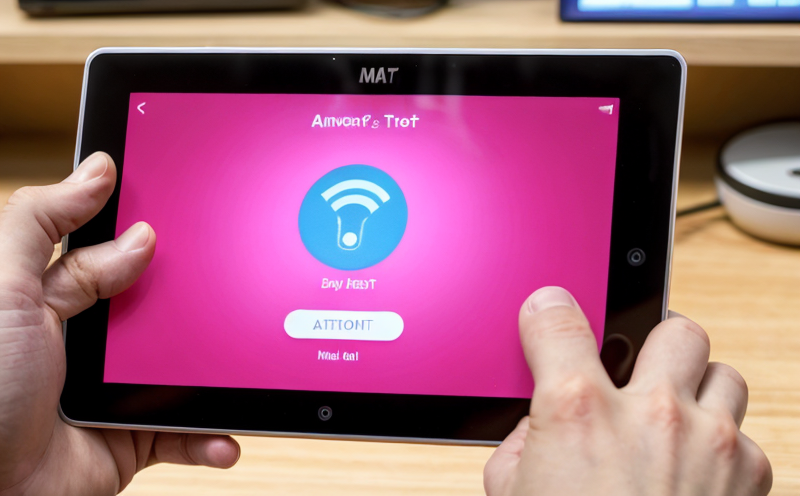Standby Power Usage Testing in Smart Devices
The concept of standby power usage testing is crucial in today's interconnected world, where smart and connected consumer devices are integral to daily life. Standby power consumption refers to the energy consumed by a device when it is switched off or in sleep mode but is still connected to an electrical outlet. This form of power consumption can have significant implications for both individual users and large-scale consumers like businesses and governments.
Smart consumer devices, such as smart home appliances, wearables, and IoT-enabled gadgets, are designed to offer convenience and efficiency by remaining connected even when not actively in use. However, this connectivity often results in continuous power consumption during standby mode, which can lead to higher electricity bills and increased environmental impact.
In the consumer products sector, ensuring that devices meet stringent energy standards is critical for both regulatory compliance and brand reputation. For instance, the United States has regulations like DOE Efficiency Standards which mandate maximum standby power consumption levels for various types of appliances and electronics.
The European Union also imposes strict limits through its Standby Mode Power Consumption Regulation. These regulations aim to reduce energy waste by encouraging manufacturers to design products with lower standby power consumption. By testing devices for standby power usage, quality managers and compliance officers can ensure their products meet these stringent standards.
Testing is typically conducted using specialized equipment that simulates real-world conditions. The apparatus used includes a calorimeter or an equivalent device to measure the heat output of the device under test (DUT) while it is in standby mode. This allows for accurate measurement and comparison against specified limits set by relevant standards.
Standby power usage testing involves placing the device in its designated sleep or off mode, then monitoring the current drawn over a period of time using an ammeter or similar instrument. The duration of this observation can vary depending on the type of product being tested; however, it is usually set to at least 12 hours.
The results are compared against predefined thresholds outlined in applicable international standards such as ISO/IEC 62301 for IT equipment or IEC 62301-1:2017. Compliance with these standards is essential not only to avoid penalties but also to maintain a competitive edge in the market.
Testing for standby power usage is particularly important given the rapid advancement of technology and increasing demand for connected devices. As more products enter the market, it becomes increasingly necessary to assess their environmental impact early on during development stages. This proactive approach helps manufacturers identify areas where they can reduce energy waste without compromising functionality or user experience.
Understanding standby power consumption is not just about meeting regulatory requirements; it plays a vital role in enhancing product design and innovation. By optimizing the efficiency of devices while maintaining performance levels, companies can create products that are more sustainable and cost-effective for consumers over time.
Applied Standards
| Standard Name | Applicable Products | Main Requirements |
|---|---|---|
| ISO/IEC 62301 | IT equipment and consumer electronics | Defines the methodology for measuring standby power consumption. |
| IEC 62301-1:2017 | IT equipment and consumer electronics | Includes specific requirements for power consumption during different modes of operation, including standby. |
| DOE Efficiency Standards | Appliances sold in the United States | Establishes maximum allowable standby power consumption for various appliance types. |
| Standby Mode Power Consumption Regulation (EU) | Electrical devices sold in the EU | Limits the amount of power that can be consumed during standby mode. |
Scope and Methodology
The scope of standby power usage testing encompasses a wide range of smart consumer devices. These include everything from smartphones to smart home thermostats, wearable technology like fitness trackers, and various other IoT-enabled gadgets.
- Smartphones: Testing ensures that even when the device is in sleep mode or powered off but still connected via USB, it does not consume excessive power.
- Wearables: Devices such as smartwatches must adhere to strict standards regarding standby power consumption to ensure minimal battery drain when not actively being used.
- Smart Home Appliances: From refrigerators to washing machines, these devices need to be optimized for minimal energy use during idle periods.
The methodology involves simulating real-world conditions as closely as possible. This includes setting the device in its designated sleep or off mode and monitoring the current drawn over a standard period of time using an ammeter or similar instrument. The duration can vary based on the product type but is typically set to at least 12 hours.
The results are then compared against predefined thresholds outlined in applicable international standards such as ISO/IEC 62301 for IT equipment or IEC 62301-1:2017. Compliance with these standards ensures that the tested devices meet regulatory requirements and contribute to overall energy efficiency efforts.
Testing is an ongoing process that should be integrated into the product development lifecycle. By incorporating standby power usage testing early on, manufacturers can identify potential issues during design phases rather than waiting until later stages when changes become more costly and challenging to implement.
Benefits
Compliance with regulatory requirements and avoidance of potential penalties.
Enhanced reputation among consumers who value sustainability and energy efficiency.
Identification of opportunities for improving product design through optimization of standby power usage.
Cost savings for manufacturers by reducing unnecessary energy waste during idle periods.
Contribution to global efforts towards reducing carbon footprints and promoting eco-friendly practices.
Improved user satisfaction due to longer battery life on portable devices like smartphones and wearables.





